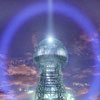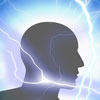Free Energy ~ Part II
 by Herbert G. Dorsey III
by Herbert G. Dorsey III
The electric field can also be used to create free energy machines. Thomas Townsend Brown discovered an interesting effect which connected the electric and gravitational field in the 1920s. Whenever a simple parallel plate capacitor is charged to a sufficiently high voltage, a force on the entire capacitor in the direction of the positive plate is created. The voltage needs to be higher than 30,000 volts to be noticeable.
Brown and a professor at his college named Biefield did considerable experimenting with this effect and concluded that it was an electrogravitic phenomena. In other words, the high electric field was creating a “gravitational well” which the capacitor kept falling into. This effect, which is virtually ignored in physics, is known as the Biefield-Brown effect.
Later, Brown developed “gravitators” made from these high voltage capacitors. Even though these gravitators required a very high voltage, if properly insulated, very small leakage currents were involved. Typically voltages of 300,000 volts and with currents of millionths of an ampere were involved. So, actual power consumed was on the order of a quarter to a half of a watt.
He placed these gravitators in model trains with the positive plates forward as propulsion devices which worked quite well. Gravitators placed in model boats propelled the boats forward as well as the water surrounding the boat, greatly reducing friction.
Then, he placed these gravitators around a wheel so that the forces produced would cause the wheel to turn. Brown found that this wheel could be attached to an electrical generator and generate much more electric power than the gravitators consumed.
A very important principle in free energy is that of resonance. In a typical city there may be dozens of radio stations transmitting simultaneously. If your radio received them all at the same time, you would get a lot of unintelligible noise. Nikola Tesla invented the tuned circuit, in which a capacitor-coil combination will only resonate at a single frequency. So, by varying the capacitance with a variable capacitor or variable coil, the resonant condition of the tuning circuit in your radio will change and be able to “tune in” the desired station while rejecting all the others.
A similar situation occurs with tuning forks. If you bring a still tuning fork near a vibrating tuning fork of the same frequency, it will also start vibrating. If you bring a still tuning fork of a different frequency near the vibrating fork nothing will happen to it.
Now the interesting thing is what happens if you bring a hundred still tuning forks of the same frequency near a vibrating tuning fork of that frequency? The correct answer is they all will start vibrating. In fact, here we have multiplied the energy of the first vibrating tuning fork a hundred fold!
How much more power will a 100 kilowatt radio transmitter use when 10,000 radio receivers are tuned in, than when only a 10 radio receivers are tuned in to that station? The correct answer is no more power.
Inventor Donald Smith used these resonant principles with Tesla coils to create a free energy device. He fed oscillating electrical energy into the primary winding of a central Tesla coil. Around this central coil, he placed more identical Tesla coils tuned to the same frequency. These coils also started oscillating at the same frequency. He could then take the electrical energy from the primaries of the surrounding coils add them together and multiply the original energy by a factor depending on the number of the surrounding coils. As with most of Don Smith’s free energy inventions, the operating principle was quite simple and effective.
A parametric amplifier can be made by either varying the capacitance or inductance of a tuned circuit at the same frequency (or twice the frequency) that the circuit is tuned to. When this condition is satisfied, the power of the oscillations is dramatically increased. This is another phenomenon of resonance.
Some question where the extra power comes from. Some use quantum physics to explain power amplification by parametric amplifiers. But, simply, if one realizes that both the electric and magnetic fields are Aether in motion and this motion is a collective motion in the otherwise chaotic motion of Aether particles traveling at the velocity of light, one could understand where the energy is coming from. The parametric resonance condition coheres a small fraction of the total energy present in the Aether into these oscillating electric and magnetic fields.
The rate of power amplification is related to the frequency of the parametric oscillator. So, when designing microwave parametric oscillators, care is required that the power doesn’t build up faster than the load can dissipate it. These devices have been known to explode from exponential increases in power.
Varactor diodes are typically used in high frequency parametric amplifiers because their internal capacitance changes with applied voltage. Varying the applied voltage across the varactor diode at the resonant frequency of the tuned circuit causes the parametric amplification phenomenon. Usually, a means to shift the frequency of the pulses fed to the varactor diode is used to shift its frequency from resonance when the power becomes too great. This detunes the parametric amplifier and reduces excessive power buildup.
Another free energy device that uses the principle of resonance and parametric amplification is the Quantum Energy Generator (QEG).
In this design, a rotor made of a good magnetic conductor like steel is rotated between the pole pieces of a toroidal arrangement of four coils. Two opposing coils are in series with a capacitor bank and the other two opposing coils are the power output.
The rotor is connected to a small motor which speed is varied with a Variac. This rotor effectively changes the inductance of the coils by varying the magnetic flux path of the coils. An exciter circuit starts the voltage flowing in the output coils, which through transformer action, induces voltage into the coil capacitor combination.
When the rotor RPMs match the resonant frequency of the coil capacitor combination, the circuit is “in tune.” The circuit acts as a parametric oscillator and the power is multiplied. And, by induction, the varying magnetic flux induces power into the output coils. The output power is considerably greater than the power to rotate the rotor. Once the rotor has the resonant RPMs, some of the output power can be fed back to the rotor motor to keep the unit self-running. Then, no input power is required to run the QEG. Off grid units would have to be started with a battery and inverter combination.
The complete set of plans for a 10 KW version of the QEG, including parts specification, is being open sourced to prevent its suppression and is available here.
Of course, one could also run your car on water, which is a much better fuel than gasoline. Hydrogen has the highest energy density of any fuel and oxygen is the perfect oxidizer. When hydrogen burns, it combines with oxygen to produce harmless water vapor as an exhaust. So, there is no harmful air pollution.
The water molecule is a combination of one oxygen atom combined with two hydrogen atoms. So, all that has to be done is break the water molecule into its parts, hydrogen and oxygen. One process to do this is electrolysis of water.
Typically the voltage from your 12 volt car battery is fed to oppositely charged plates immersed in a cell filled with water. Hydrogen gas evolves at one plate and oxygen gas at the other. This gas mixture is then fed into the carburetor. The problem with standard electrolysis is that it doesn’t produce hydrogen fast enough. So, the usual hydroxy gas kits sold on the market only work to boost gas mileage rather than to replace gasoline all together.
However some inventors have discovered more efficient ways to electrolyze water into hydrogen and oxygen gas. Pulsing the current to the cells seems to improve the efficiency of gas production. Some inventors claim to pulse the current at the frequency that the water molecule vibrates, creating a resonant situation which literally breaks the water molecule apart much the same way an opera singer can shatter a glass by singing a note that is the resonant frequency of the glass.
Stanley Meyer and Bob Boyce, two well-known experimenters among others, have actually run their vehicles on straight water by using pulsed current electrolyzers. Before building your own, understand that hydrogen gas is highly explosive and you should study the information and advice on this subject that is available in books and the internet by those that have plenty of experience.
One experimenter accidentally replicated Keeley’s Aether-realization of water. He was using a quartz column with a 5.08 cm ID and a Barium Titanate ultrasonic transducer at the bottom. Above the transducer an approximately 10 cm height of water filled the quartz tube. An ultrasonic frequency generator and amplifier combination was feeding about 600 watts of power to the transducer. The experimenter started with a signal of 40,000 Hz which caused about three wavelengths in the 10 cm of water. The frequency was gradually increased until, at about 41,300 Hz, the water in the tube disappeared!
The experimenter looked up at the ceiling right above the tube and saw a clean cut hole in the ceiling that also went through the roof! Another experimenter replicated this experiment and found a similar result at a much lower power than 600 watts.
Supposing these experiments were conducted in strong steel containers and the Aetherealized water vapor stored in a strong steel tank. Supposedly a high pressure would be built up in the tank, as Keeley had discovered. This pressure could perhaps be used to operate an air motor to harness the energy of this process. Here again is another free energy concept.
There are many more ways to tap the ambient energy of the medium of space, whether one calls it Aether, virtual particles, or dark matter, and convert it into useful energy. I don’t have the space to entirely cover this vast subject. If you are interested and want more ideas on this subject check out: http://www.free-energy-info.co.uk/PJKBook.html
More reference material: The Manual Of Free Energy Devices And Systems, Eric Dollard Notes, Universal Laws Never Before Revealed
Excerpt from The Science And Technology Of Free Energy
See Part I here.
Posted in Other Topics, Science For The New Agewith comments disabled.





